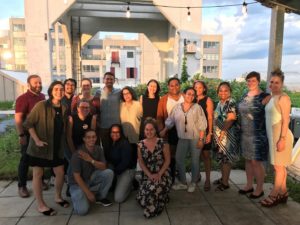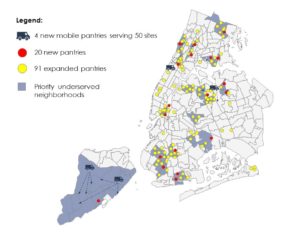Earlier this summer, we had a chance to get together with our peers from the New York City Food Assistance Collaborative to celebrate all that the group had accomplished over the past 4+ years. Taking a moment to step back revealed just how much the city’s pantry and soup kitchen network had changed thanks to a deliberate, thoughtful coordination between the food suppliers.

Above, the core work team of the Food Assistance Collaborative gathers for an event at the Brooklyn Grange rooftop farm.
When the Collaborative began, the city’s charitable food suppliers lacked basic data about where food was going and where more was needed, creating significant inefficiencies and inequalities across neighborhoods. The Helmsley Trust and the Mayor’s Office of Food Policy convened and funded several of the city’s largest emergency food suppliers to increase equity, efficiency, and dignity in emergency food distribution.
The effort successfully knit together a disparate network of government and non-profit entities, and helped them function like a unified system. Thanks to these efforts, the group was able to:
- Create the first-ever map of where food was going and where more was needed, and build a central data-warehouse to continue tracking this for future years
- Fund pantry expansions, or create new pantries, at 115 sites across the city that were most underserved
- Build the infrastructure and secure the food supply to distribute another 16 million pounds of food annually, in perpetuity, to these areas
- Launch a leadership and organizational development program to expand and stabilize some of the city’s largest new pantries
- Incubate Plentiful, the nation’s first mobile app for creating pantry reservations; it functions like an OpenTable for pantry appointments, and has processed over 1.2 million appointments, saving clients countless hours of waiting in line
- Create and spread tools for increasing client dignity at pantries through “supermarket-style” pantry setups and multi-lingual signage

Map showing illustrative locations of pantries created or expanded by the Collaborative’s work.
Redstone served as the support team for the Collaborative, helping the group define its strategy, analyze data, measure progress, and coordinating a structured process for collaboration.
Looking back, it is clear that no one member of the Collaborative could have accomplished any of these items alone. The intentional structure put in place – which required developing clear action plans, agreeing on shared metrics, and tracking progress regularly to monitor impact – were key to these successes. We believe this effort is only the beginning of what NYC’s food suppliers can accomplish together, and are excited to see how they continue to build on this foundation to do even more.
To watch a short clip about the Collaborative’s work, click here.